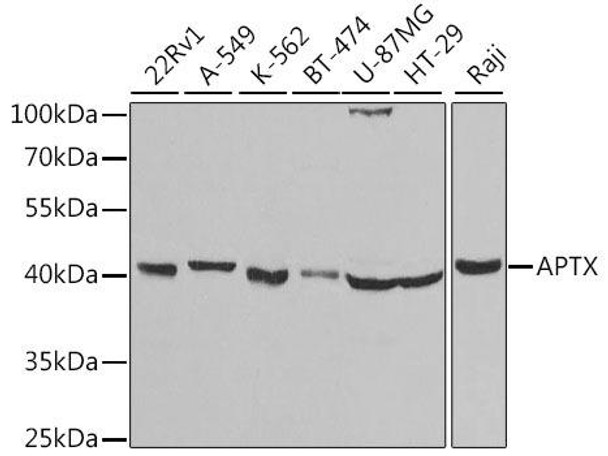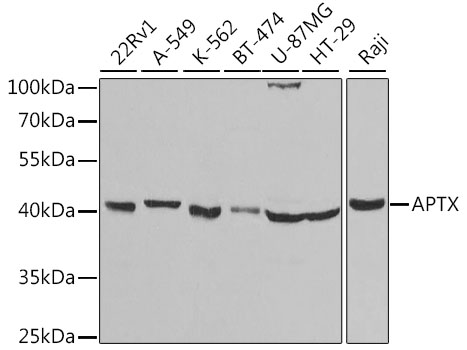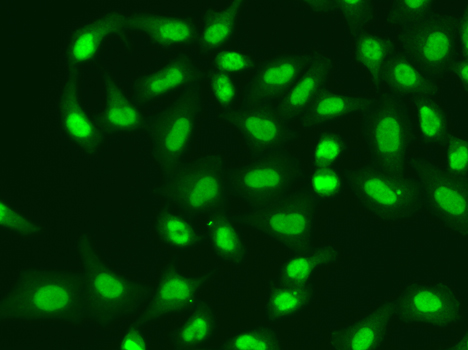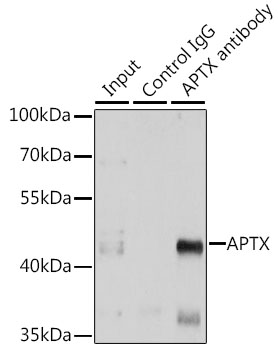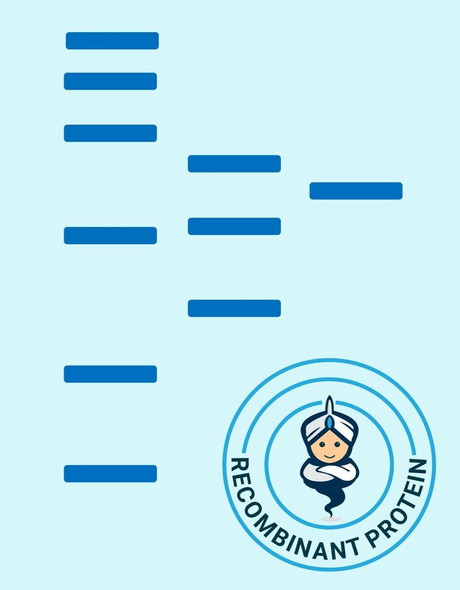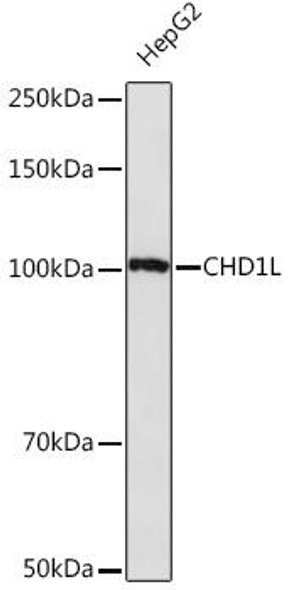Anti-APTX Antibody (CAB5364)
- SKU:
- CAB5364
- Product type:
- Antibody
- Reactivity:
- Human
- Host Species:
- Rabbit
- Isotype:
- IgG
- Antibody Type:
- Polyclonal Antibody
- Research Area:
- Epigenetics and Nuclear Signaling
Description
| Antibody Name: | Anti-APTX Antibody |
| Antibody SKU: | CAB5364 |
| Antibody Size: | 20uL, 50uL, 100uL |
| Application: | WB IF IP |
| Reactivity: | Human |
| Host Species: | Rabbit |
| Immunogen: | Recombinant fusion protein containing a sequence corresponding to amino acids 93-342 of human APTX (NP_001182178.1). |
| Application: | WB IF IP |
| Recommended Dilution: | WB 1:500 - 1:2000 IF 1:50 - 1:100 IP 1:20 - 1:50 |
| Reactivity: | Human |
| Positive Samples: | 22Rv1, A-549, K-562, BT-474, U-87MG, HT-29, Raji |
| Immunogen: | Recombinant fusion protein containing a sequence corresponding to amino acids 93-342 of human APTX (NP_001182178.1). |
| Purification Method: | Affinity purification |
| Storage Buffer: | Store at -20°C. Avoid freeze / thaw cycles. Buffer: PBS with 0.02% sodium azide, 50% glycerol, pH7.3. |
| Isotype: | IgG |
| Sequence: | LYPY IVEF EEEA KNPG LETH RKRK RSGN SDSI ERDA AQEA EAGT GLEP GSNS GQCS VPLK KGKD APIK KESL GHWS QGLK ISMQ DPKM QVYK DEQV VVIK DKYP KARY HWLV LPWT SISS LKAV AREH LELL KHMH TVGE KVIV DFAG SSKL RFRL GYHA IPSM SHVH LHVI SQDF DSPC LKNK KHWN SFNT EYFL ESQA VIEM VQEA GRVT VRDG MPEL LKLP LRCH ECQQ LLPS IPQL KEHL RKHW TQ |
| Gene ID: | 54840 |
| Uniprot: | Q7Z2E3 |
| Cellular Location: | Cytoplasm, Nucleus, nucleolus, nucleoplasm |
| Calculated MW: | 5kDa/13kDa/19-40kDa |
| Observed MW: | 40kDa |
| Synonyms: | APTX, AOA, AOA1, AXA1, EAOH, EOAHA, FHA-HIT, aprataxin |
| Background: | This gene encodes a member of the histidine triad (HIT) superfamily. The encoded protein may play a role in single-stranded DNA repair through its nucleotide-binding activity and its diadenosine polyphosphate hydrolase activity. Mutations in this gene have been associated with ataxia-ocular apraxia. Alternatively spliced transcript variants have been identified for this gene. |
| UniProt Protein Function: | APTX: DNA-binding protein involved in single-strand DNA break repair, double-strand DNA break repair and base excision repair. Resolves abortive DNA ligation intermediates formed either at base excision sites, or when DNA ligases attempt to repair non- ligatable breaks induced by reactive oxygen species. Catalyzes the release of adenylate groups covalently linked to 5'-phosphate termini, resulting in the production of 5'-phosphate termini that can be efficiently rejoined. Also able to hydrolyze adenosine 5'- monophosphoramidate (AMP-NH(2)) and diadenosine tetraphosphate (AppppA), but with lower catalytic activity. Defects in APTX are the cause of ataxia-oculomotor apraxia syndrome (AOA). AOA is an autosomal recessive syndrome characterized by early-onset cerebellar ataxia, oculomotor apraxia, early areflexia and late peripheral neuropathy. 13 isoforms of the human protein are produced by alternative splicing. |
| UniProt Protein Details: | Protein type:Nucleolus; EC 3.-.-.-; C2H2-type zinc finger protein; RNA-binding; Phosphatase (non-protein); DNA repair, damage Chromosomal Location of Human Ortholog: 9p13.3 Cellular Component: nucleoplasm; nuclear chromatin; cytoplasm; nucleolus; chromatin; nucleus Molecular Function:protein binding; DNA 5'-adenosine monophosphate hydrolase activity; phosphoglycolate phosphatase activity; polynucleotide 3'-phosphatase activity; metal ion binding; double-stranded DNA binding; double-stranded RNA binding; damaged DNA binding; phosphoprotein binding; protein N-terminus binding; chromatin binding Biological Process: single strand break repair; response to hydrogen peroxide; dephosphorylation; double-strand break repair; regulation of protein stability; DNA catabolic process, exonucleolytic; response to DNA damage stimulus; DNA ligation Disease: Ataxia, Early-onset, With Oculomotor Apraxia And Hypoalbuminemia |
| NCBI Summary: | This gene encodes a member of the histidine triad (HIT) superfamily. The encoded protein may play a role in single-stranded DNA repair through its nucleotide-binding activity and its diadenosine polyphosphate hydrolase activity. Mutations in this gene have been associated with ataxia-ocular apraxia. Alternatively spliced transcript variants have been identified for this gene.[provided by RefSeq, Aug 2010] |
| UniProt Code: | Q7Z2E3 |
| NCBI GenInfo Identifier: | 48428038 |
| NCBI Gene ID: | 54840 |
| NCBI Accession: | Q7Z2E3.2 |
| UniProt Secondary Accession: | Q7Z2E3,Q0P662, Q5T781, Q5T782, Q5T784, Q6JV81, Q6JV82 Q6JV85, Q7Z2F3, A8MTN4, D3DRK9, D3DRL0, |
| UniProt Related Accession: | Q7Z2E3 |
| Molecular Weight: | |
| NCBI Full Name: | Aprataxin |
| NCBI Synonym Full Names: | aprataxin |
| NCBI Official Symbol: | APTX |
| NCBI Official Synonym Symbols: | AOA; AOA1; AXA1; EAOH; EOAHA; FHA-HIT |
| NCBI Protein Information: | aprataxin; forkhead-associated domain histidine triad-like protein |
| UniProt Protein Name: | Aprataxin |
| UniProt Synonym Protein Names: | Forkhead-associated domain histidine triad-like protein; FHA-HIT |
| Protein Family: | Aprataxin |
| UniProt Gene Name: | APTX |
| UniProt Entry Name: | APTX_HUMAN |

